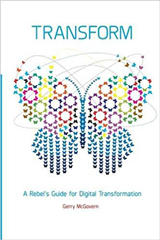[greybox]
 A review of
A review of
Transform: A Rebel’s Guide for Digital Transformation
Silver Beach Publishing
About this book
by Gerry McGovern
A good reference for Methods/How-To, UX Theory, Case Studies
Primary audience: Researchers who are new to the topic or have some experience with the topic
Writing style: Humorous, matter-of-fact
Silver Beach Publishing, 193 pages, 17 chapters
Learn more about our review guidelines
[/greybox]
Gerry McGovern’s Transform: A Rebel’s Guide for Digital Transformation is likely not a conventional read for those working in user experience, but maybe it should be. Its focus is helping companies and teams develop a more customer-centric perspective.
While this certainly sounds relevant to user-centered design professionals, the author elevates the conversation on customer-centricity beyond tangible things like the design of digital products to questions of culture, management philosophy, and overall organizational design. Most importantly, he provides some methods for quantifying the customer experience that will likely appeal to non-UX audiences within your organization.
McGovern begins by laying out how technology has transferred power from organizations to users, necessitating a shift in how those working within organizations should think about their priorities. Namely, he argues that organizations must shift from thinking about themselves to thinking about what customers want and need. Along the way he touches on topics such as the increasing importance of design, the rise in information-savvy and skeptical customers, and the value of using Big Data to bridge the distance between organizations and customers created by the digital world.
In painting a picture of how the world is evolving due to the aforementioned “power-shift,” Transform puts forth a solid case for why design skills and thinking will be critical for all organizations that wish to remain relevant and navigate change successfully.
McGovern provides some data points and research for this noting that:
- More customer-centricity will require more designers. “If a modern company has customer experience at its heart, then roughly one in 10 employees will be designers,” according to Andreas Hauser, Global Head of Design for SAP.
And,
- Design-led companies perform better financially. “Design-led companies have outperformed the S&P by 228% between 2003 and 2013.” (Golden Age of Digital Designers, Chapter 4)
A major organizing principle of the book is the concept of “Top Tasks Management,” defined as:
- Using data to determine customers’ top tasks: “What really matters to [them]”
- Measuring how easily customers can complete these tasks and closely tracking metrics related to task completion as a way to gauge the success of the organization
- Create teams around top tasks and make teams responsible for success of customers at completing tasks (i.e., “Employees manage and are responsible for customer task outcomes”)
The first two points might sound very similar to actions you take when practicing user experience methods such as task analysis or usability testing. However, the third point is what makes the approach of the book helpful for usability professionals who want to engage non-UX leaders and stakeholders in your company. In addition to identifying top tasks and measuring task completion, McGovern advocates for creating teams organized around the tasks and making employees responsible for customer success. This has the effect of institutionalizing user-centered design principles within the organization.
He also provides guidance for the process to use to help your company identify its customers’ top tasks. The process involves using tools and resources such as surveys, social media, search data, and web analytics to develop a comprehensive list of tasks usually ranging from 300-500. Once all tasks are identified, you must differentiate between tiny tasks, things that are important to your organization, but not necessarily your customer, and top tasks. Some examples of tiny tasks on a website might be press releases, company leadership profiles, and annual reports. To weed out tiny tasks, he recommends filtering the list (down to less than 100 or so) using a group of stakeholders within the organization and validating by asking customers to rank them.
One aspect of the customer validation that I like is his recommendation to have the stakeholders rank the tasks as well. This allows your team to assign an empathy score to each item—the team’s vote divided by the customer’s collective vote. What I like about this approach is that it provides a way to quantify how closely the organization’s thinking does or does not align with the customer’s thinking.
Another great example of McGovern’s ability to lend a quantitative perspective to customer-centricity is the Task Performance Indicator. This is a “score” that demonstrates the customer experience. It measures how often a task is completed successfully (typically within a specific time frame) and also takes into account how confident the user is that she has completed it. Similar to the empathy calculation, I like that this indicator provides a number that can help build a business case for making changes to the customer experience. Overall, I think this book is a really helpful read for any usability professionals who wish to instill a greater focus on user-centered design within their organizations. Think of it as a playbook of sorts that you can use to not only lead conversations on the growing importance of design thinking and customer-centricity in your company, but offer measurable ways for how to bake it into all aspects of the company.
If you want to try before you buy, read the first full chapter for free.
